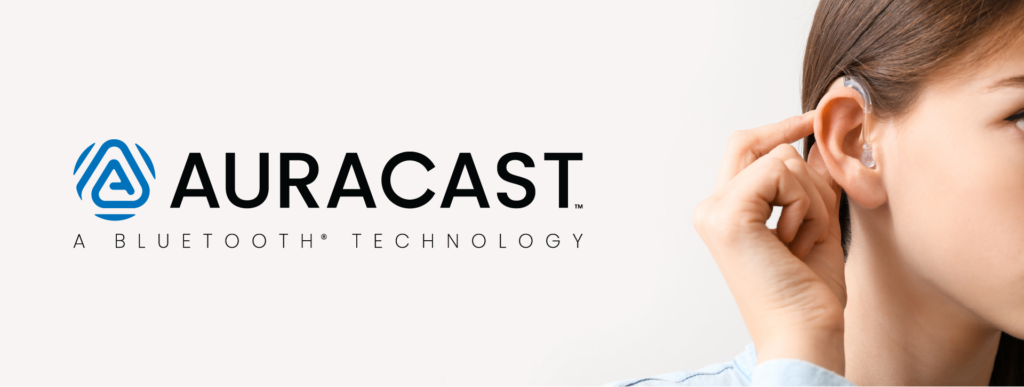
Does Auracast spell the end for the telecoil?
The collaboration between Ampetronic and Listen Technologies to bring the next generation of large area assistive listening technology to market has sparked significant excitement.
Utilising the new Bluetooth standards for Low Energy broadcast audio, Ampetronic sees the huge potential for Auracast as an assistive listening technology.
But what are the implications of Auracast on the telecoil, one of the most widely used assistive listening technologies currently available?
The Current Landscape
Hearing loops, paired with telecoil enabled hearing devices, are currently the only technology that allows direct broadcast audio to a large proportion of hearing aid users, and that’s not set to change any time soon.
A review of hearing aids on the market in 2020 revealed that 80% of all models had telecoils available either fitted as standard or via an accessory[1] making this a widely available technology.
Decades of investment have contributed to the extensive infrastructure supporting these systems in numerous public spaces. Ampetronic, with a legacy dating back to 1987, has played a pivotal role in delivering hearing loop systems into a global market. These systems have enhanced audio accessibility across a diverse range of environments, including educational and meeting spaces, places of worship, theatres and stadiums, but also in service counters, help points and on-board vehicles such as taxis, buses and trains.
Hearing aid users are used to seeing the familiar telecoil signage in their day-to-day life to identify where they can benefit from this widespread service.
Auracast Adoption
At time of writing on the other hand, news of Auracast compatible hearing devices is few and far between. There have been some announcements, such as the Nexia from ReSound[2] and the Cochlear Nucleus 8[3], so we should expect early adopters to get their hands on devices through 2024, but there are many leading brands who are yet to show their hands when it comes to entering the Auracast market. Given hearing aids last 3 to 7 years[4] you can imagine how long it will take to get from these first products being announced to the level of mass market availability and adoption that we currently see with telecoils.
The Bluetooth SIG themselves suggest the timescale for market saturation of Auracast technology could take decades[5].
Consumer devices such as the Samsung Galaxy Buds 2Pro[6] may see faster adoption of Auracast, this certainly widens the user base who will benefit from these systems but provides little advantage for those with the biggest need.
Accessibility
So if hardly anyone will have a compatible device, why release a transmitter now?
It’s no mistake that Ampetronic and Listen Technologies are releasing a platform geared towards use of dedicated receivers. At launch this should be considered as a system more equivalent to infrared or FM ALS, rather than a hearing loop.
Where practical to install a loop system that should still be considered as a primary choice for accessibility now, little has changed since hearing loops and telecoils were the preferred technology of choice by 86% of hearing aid users[7].
Part of this is also ease of access, in many cases accessing a loop is as simple as seeing the recognised signage and pressing a button or switch on the hearing aid. There is only one channel of audio available, and there’s no doubt that the audio you’re connecting to is trustworthy.
For Auracast there are still some questions to be answered. In most cases we anticipate that the hearing aid will require an “assistant” to help it connect[8]. This will likely be a smartphone which will scan for available broadcasts and let you select one for the hearing aid to connect to. In some cases, a password may be required for more secure environments. There may be scenarios where QR codes, NFC tags or low power BLE beacons can be used to allow connection, but these each come with their own challenges.
It may be that some hearing aids allow a single button press which will connect to the strongest available assistive listening stream, however given this will be a commoditised technology there are associated risks that you may inadvertently connect to a broadcast from a nearby phone or laptop, rather than the venue’s installed ALS.
Lastly one of the most common applications for hearing loops is service counters, they are seen in countless banks, reception desks and retail counters. This is a scenario where currently hearing loop is the only viable assistive listening technology as it’s impractical to hand over a receiver for such a short duration of time. The same applies in other transient environments such as transport concourses, waiting areas and on-board vehicles themselves.
None of these applications are suitable candidates for Auracast technology until the level of end user devices meets a critical mass.
Coexistence of Technologies
For all these reasons it’s imperative that these technologies co-exist for many years to come. As well as the Bluetooth SIGs stance, the International Federation of the Hard of Hearing (IFHOH) released a positioning statement[10] at their 2022 congress which underlines the importance of this.
This coexistence works in two ways, hearing aid and cochlear implant manufacturers must understand the importance of catering for the user base who benefit from the vast loop infrastructure that already exists in many countries and continue to make telecoil options available in their hearing aids. An Auracast enabled hearing aid is not as appealing when there are no public transmitters installed yet.
For venue operators, consultants and integrators, where no current ALS provision exists there cannot be a wholesale switch to the installation of Auracast solutions, as that alienates the majority of hearing aid users who could benefit from a loop system.
Ideally existing loop installations should be maintained and supplemented with an Auracast transmitter to future proof the provision. In new installations where practical both technologies should be installed in parallel, allowing access for all.
In conclusion, while Auracast shows promise as a future assistive listening technology, the current dominance of telecoil technology, its simplicity, and widespread use necessitate a careful and prolonged coexistence of both technologies. Hearing aid manufacturers and venue operators should prioritize accessibility by supporting both telecoil and Auracast technologies, ensuring that users with varying needs can benefit from equal access to audio.
- International Hearing Loop Manufacturers Association (IHLMA). (2020, September). Telecoil availability in hearing aids. IHLMA. https://ihlma.org/wp-content/uploads/2020/09/Telecoil-availability-in-hearing-aids.pdf
- GN ReSound. Resound Nexia. https://www.resound.com/en/hearing-aids/resound-hearing-aids/resound-nexia
- Cochlear. Cochlear Nucleus 8. https://www.cochlear.com/uk/en/home/products-and-accessories/cochlear-nucleus-system/nucleus-sound-processors/nucleus-8
- Oticon. How do I know when it is time to update my hearing aids? https://www.oticon.com/your-hearing/getting-help/how-do-i-know-when-it-is-time-to-update-my-hearing-aids
- Bluetooth. Using Bluetooth Technology to Solve Assistive Listening Challenges. https://www.bluetooth.com/blog/using-bluetooth-technology-to-solve-assistive-listening-challenges/
- Samsung Newsroom. (2023, August). Galaxy Buds2 Pro evolves LE Audio capabilities, bringing new Auracast to Samsung Smart TV. https://news.samsung.com/global/galaxy-buds2-pro-evolves-le-audio-capabilities-bringing-new-auracast-to-samsung-smart-tv
- Audio Engineering Society (AES). (2015, April). Hearing Loops The Preferred Assistive Listening Technology. https://www.aes.org/technical/documentDownloads.cfm?docID=509
- Bluetooth. Auracast - How it Works. https://www.bluetooth.com/auracast/how-it-works/
- International Federation of the Hard of Hearing (IFHOH). (2022, September). Budapest Declaration, Auracast – New Bluetooth Technology: Implications for Hard of Hearing Persons. https://www.ifhoh.org/_files/ugd/4e728a_4915ab17e0984caa91110f0910ec7165.pdf



